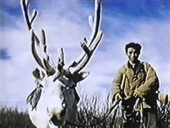One of the highlights of the 2004 New York Video Festival was Jacqueline Goss’ disarmingly whimsical and tongue-in-cheek, yet witty and incisive ethnographic video essay, How to Fix the World – an animated reenactment based on the cognitive studies of psychologist Alexander R. Luria that preceded the Soviet government’s mandate to promote Western education and literacy (and consequently, communist party allegiance) throughout the rural villages of Uzbekistan. Having recently revisited one of Chris Marker’s earliest films, Letter from Siberia, it is not difficult to imagine the spirit of iconic film essayist imbuing every frame of Goss’ charming film. On one hand, both essays assume the point of view of a distanced – and somewhat bemused – cultural outsider who objectively chronicles quotidian observations of an indigenous culture at the crossroads of profound and irreversible transformation – a historical record of a way of a life that will soon cease to exist – a reality that is (or will soon be) no longer real. On the other hand, the narrator also serves as a reflexive witness and facile commentator on the cultural repercussions of imposed assimilation, modernization, and Westernization on an Asiatic people during the Soviet government’s cross-country campaign towards collectivization and political centralization. However, while Goss’ film is rooted in the underlying interrelation between social psychology and cognition (in particular, logical deduction and problem-solving methods) that often lead to cultural misunderstanding, Marker’s perspective proves to be more amorphous and open-ended.
This stream-of-consciousness approach is perhaps best exemplified by a sequence in the film in which the camera pans from an industrial dredging site to a line of trees as the narrator changes narrative course to the Siberian taiga by commenting that a hiker cannot attempt to traverse the forest in a straight line without invariably getting lost. In a sense, the film, too, necessarily diverges even as it retains continuity from its visible line of sight as adjacent, juxtaposing images reveal the intrinsic bifurcations that open up to other points of departure – to other uncharted frontiers of exploration. Rather than focusing the complexity of observations towards a point of convergence within an overarching logical argument, the validation of the argument itself becomes secondary to the documentation of ethnographic observation. In this respect, Marker’s film proves to be groundbreaking because it diverges from the conventional cinematic approach of using montage to direct arguments towards the validation of postulate theory. Instead, Marker uses montage to underscore the contradictions and, therefore, negate the existence of a simple and encapsulable overarching theory that can neatly define the essence of a societal culture and history.
Moreover, the juxtaposition between the unnamed narrator (a prefiguration of the fictional globetrotter, Sandor Krasna in Sans Soleil) and the vanishing culture of the Siberian nomads becomes a intriguing study of the phenomenon of collective consciousness as a continuum (a theme that would also pervade Aleksandr Sokurov’s cinema): an organic transference of memory, ideas, and collective cultural history without a physical medium of exchange (a fictional photojournalist, an extinct way of life, a projected film). It is in this examination of the ephemeral nature of information exchange that ultimately elevates Letter from Siberia from exoticized (albeit idiosyncratic) travelogue to seminal exposition on the study of human consciousness, an audience transcendence from passive, curious spectator to integral lifeline within the interconnected fabric of all human history.
© Acquarello 2005. All rights reserved.
